Analyzing Student Behavior: A Report on Individual Interactions
VerifiedAdded on 2022/09/14
|15
|2615
|20
Report
AI Summary
This report presents a field study conducted at Mohawk College library, employing a non-participatory observation method to analyze student behavior. The research, informed by symbolic interaction theory, examines how students interact with each other and objects within the library environment. The study observed student activities, including book collection, group assignments, and individual study habits. The analysis focuses on the students' gestures, expressions, and interactions to understand the meanings and significance of their actions within the educational context. The findings highlight the students' reactions to deadlines, group dynamics, and adherence to library guidelines, offering insights into their social and academic behaviors. The report also includes the limitations of the study, the methodology used, and a hypothesis regarding the meaning and significance of student interactions. The study's conclusion suggests that student behavior reflects the pressures of academic work, the importance of social interaction, and the adherence to social norms within the library setting.
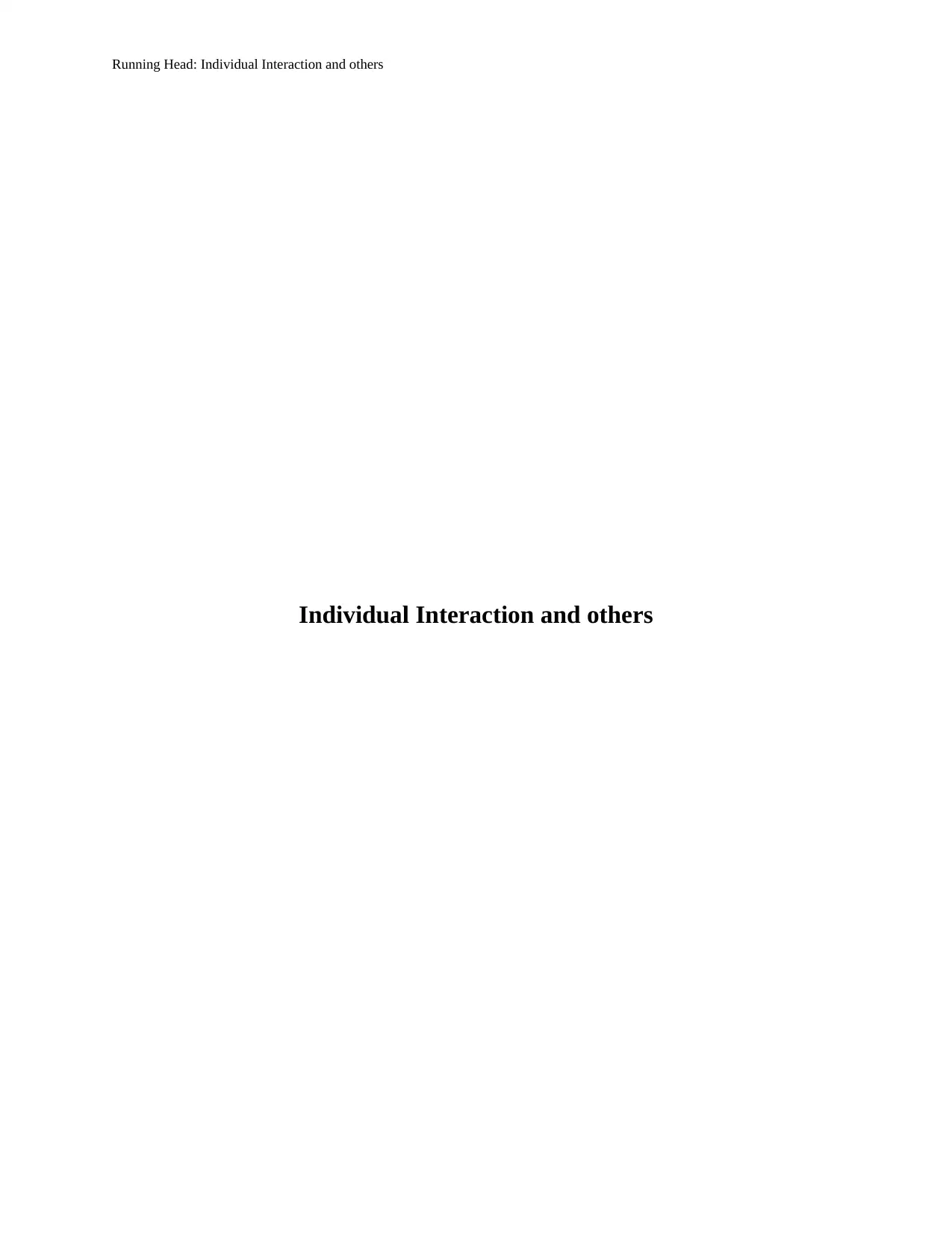
Running Head: Individual Interaction and others
Individual Interaction and others
Individual Interaction and others
Paraphrase This Document
Need a fresh take? Get an instant paraphrase of this document with our AI Paraphraser
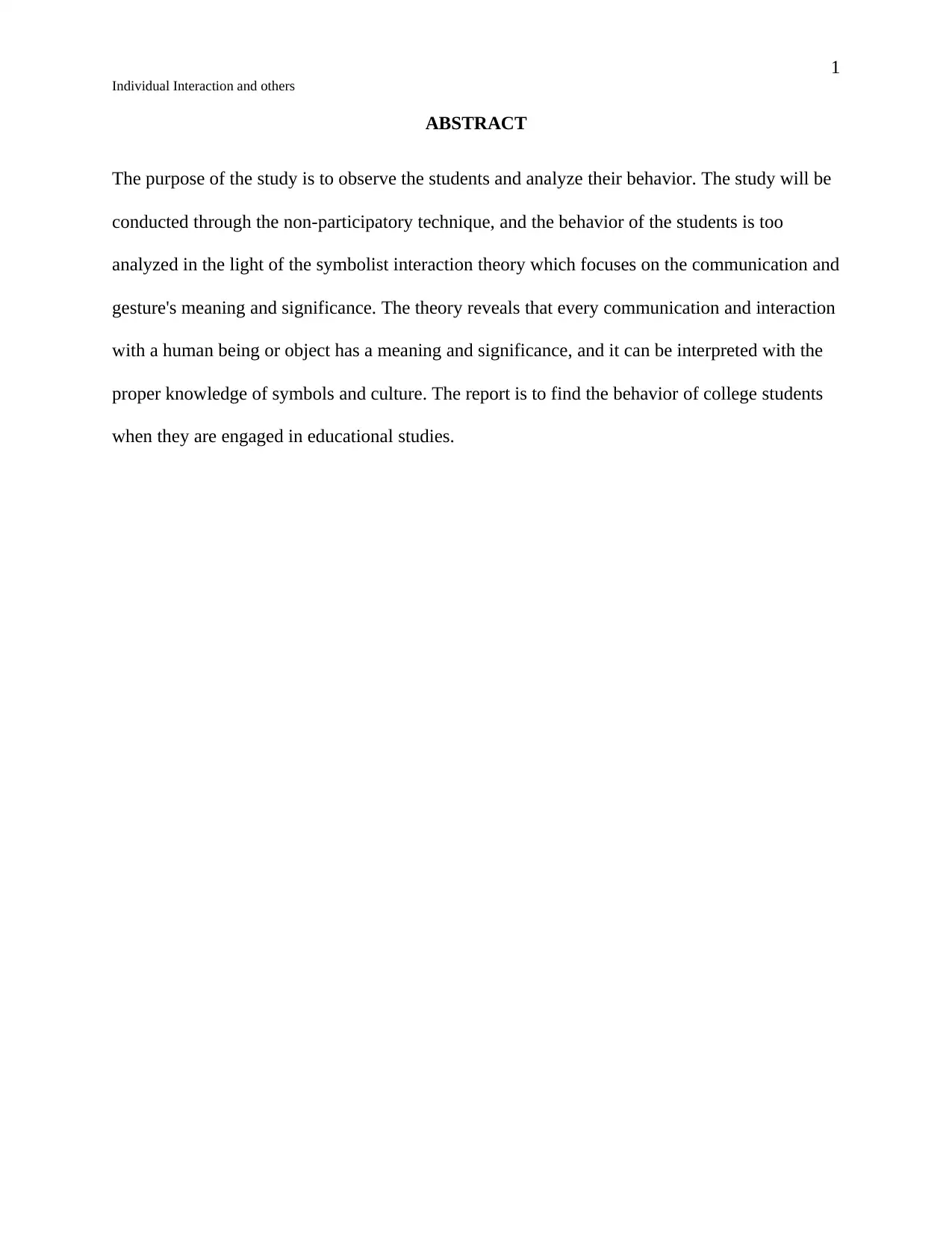
1
Individual Interaction and others
ABSTRACT
The purpose of the study is to observe the students and analyze their behavior. The study will be
conducted through the non-participatory technique, and the behavior of the students is too
analyzed in the light of the symbolist interaction theory which focuses on the communication and
gesture's meaning and significance. The theory reveals that every communication and interaction
with a human being or object has a meaning and significance, and it can be interpreted with the
proper knowledge of symbols and culture. The report is to find the behavior of college students
when they are engaged in educational studies.
Individual Interaction and others
ABSTRACT
The purpose of the study is to observe the students and analyze their behavior. The study will be
conducted through the non-participatory technique, and the behavior of the students is too
analyzed in the light of the symbolist interaction theory which focuses on the communication and
gesture's meaning and significance. The theory reveals that every communication and interaction
with a human being or object has a meaning and significance, and it can be interpreted with the
proper knowledge of symbols and culture. The report is to find the behavior of college students
when they are engaged in educational studies.
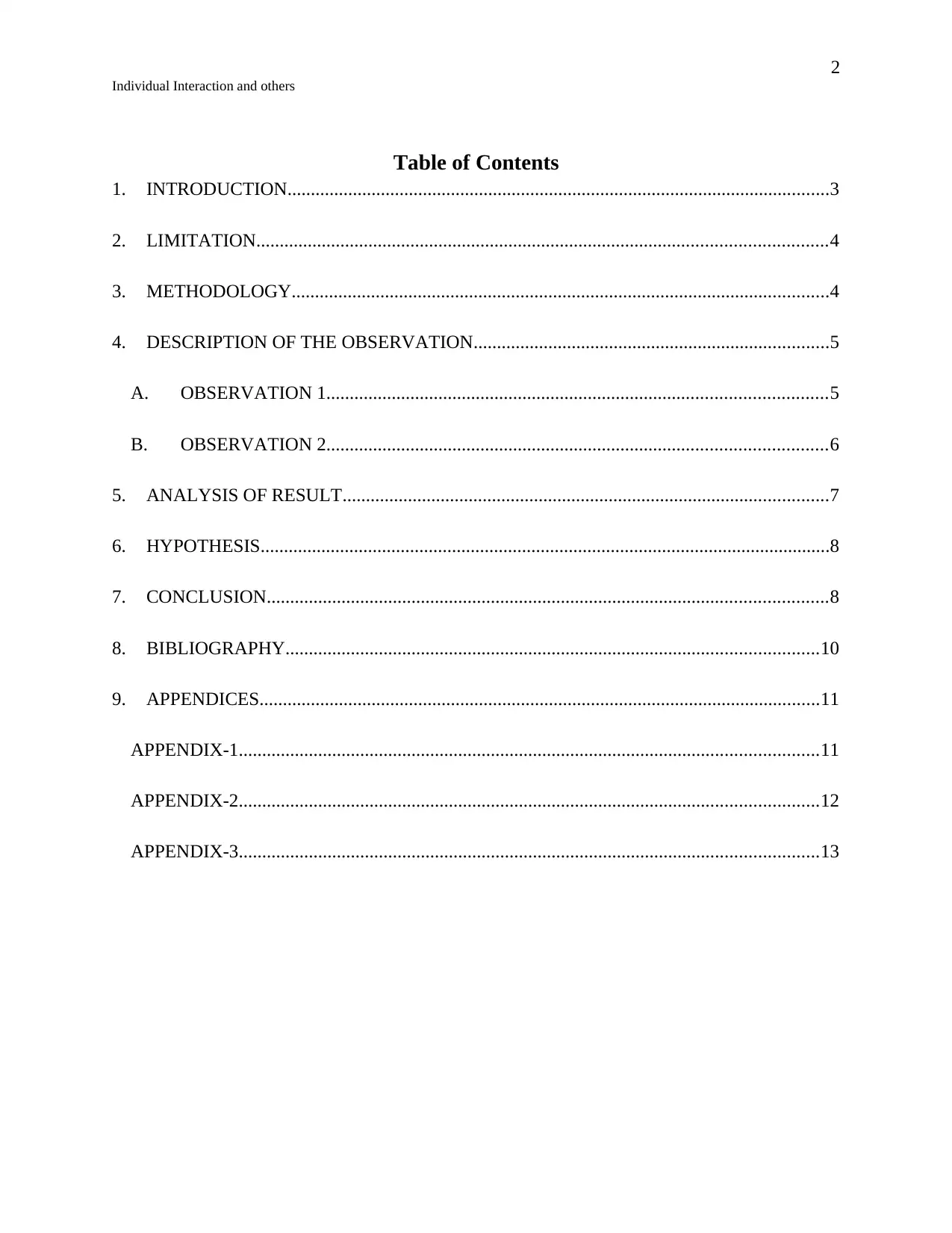
2
Individual Interaction and others
Table of Contents
1. INTRODUCTION....................................................................................................................3
2. LIMITATION..........................................................................................................................4
3. METHODOLOGY...................................................................................................................4
4. DESCRIPTION OF THE OBSERVATION............................................................................5
A. OBSERVATION 1...........................................................................................................5
B. OBSERVATION 2...........................................................................................................6
5. ANALYSIS OF RESULT........................................................................................................7
6. HYPOTHESIS..........................................................................................................................8
7. CONCLUSION........................................................................................................................8
8. BIBLIOGRAPHY..................................................................................................................10
9. APPENDICES........................................................................................................................11
APPENDIX-1............................................................................................................................11
APPENDIX-2............................................................................................................................12
APPENDIX-3............................................................................................................................13
Individual Interaction and others
Table of Contents
1. INTRODUCTION....................................................................................................................3
2. LIMITATION..........................................................................................................................4
3. METHODOLOGY...................................................................................................................4
4. DESCRIPTION OF THE OBSERVATION............................................................................5
A. OBSERVATION 1...........................................................................................................5
B. OBSERVATION 2...........................................................................................................6
5. ANALYSIS OF RESULT........................................................................................................7
6. HYPOTHESIS..........................................................................................................................8
7. CONCLUSION........................................................................................................................8
8. BIBLIOGRAPHY..................................................................................................................10
9. APPENDICES........................................................................................................................11
APPENDIX-1............................................................................................................................11
APPENDIX-2............................................................................................................................12
APPENDIX-3............................................................................................................................13
⊘ This is a preview!⊘
Do you want full access?
Subscribe today to unlock all pages.

Trusted by 1+ million students worldwide
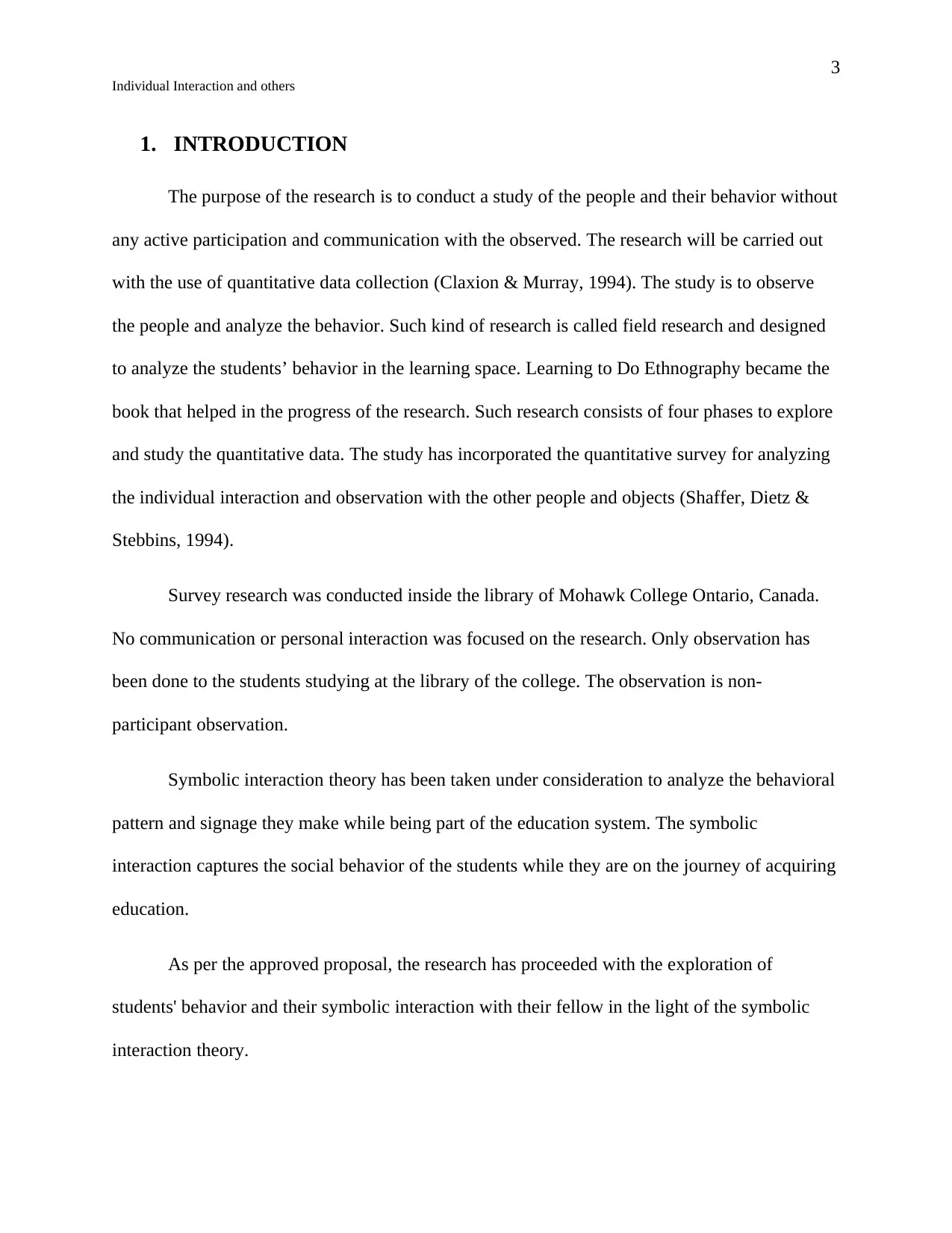
3
Individual Interaction and others
1. INTRODUCTION
The purpose of the research is to conduct a study of the people and their behavior without
any active participation and communication with the observed. The research will be carried out
with the use of quantitative data collection (Claxion & Murray, 1994). The study is to observe
the people and analyze the behavior. Such kind of research is called field research and designed
to analyze the students’ behavior in the learning space. Learning to Do Ethnography became the
book that helped in the progress of the research. Such research consists of four phases to explore
and study the quantitative data. The study has incorporated the quantitative survey for analyzing
the individual interaction and observation with the other people and objects (Shaffer, Dietz &
Stebbins, 1994).
Survey research was conducted inside the library of Mohawk College Ontario, Canada.
No communication or personal interaction was focused on the research. Only observation has
been done to the students studying at the library of the college. The observation is non-
participant observation.
Symbolic interaction theory has been taken under consideration to analyze the behavioral
pattern and signage they make while being part of the education system. The symbolic
interaction captures the social behavior of the students while they are on the journey of acquiring
education.
As per the approved proposal, the research has proceeded with the exploration of
students' behavior and their symbolic interaction with their fellow in the light of the symbolic
interaction theory.
Individual Interaction and others
1. INTRODUCTION
The purpose of the research is to conduct a study of the people and their behavior without
any active participation and communication with the observed. The research will be carried out
with the use of quantitative data collection (Claxion & Murray, 1994). The study is to observe
the people and analyze the behavior. Such kind of research is called field research and designed
to analyze the students’ behavior in the learning space. Learning to Do Ethnography became the
book that helped in the progress of the research. Such research consists of four phases to explore
and study the quantitative data. The study has incorporated the quantitative survey for analyzing
the individual interaction and observation with the other people and objects (Shaffer, Dietz &
Stebbins, 1994).
Survey research was conducted inside the library of Mohawk College Ontario, Canada.
No communication or personal interaction was focused on the research. Only observation has
been done to the students studying at the library of the college. The observation is non-
participant observation.
Symbolic interaction theory has been taken under consideration to analyze the behavioral
pattern and signage they make while being part of the education system. The symbolic
interaction captures the social behavior of the students while they are on the journey of acquiring
education.
As per the approved proposal, the research has proceeded with the exploration of
students' behavior and their symbolic interaction with their fellow in the light of the symbolic
interaction theory.
Paraphrase This Document
Need a fresh take? Get an instant paraphrase of this document with our AI Paraphraser
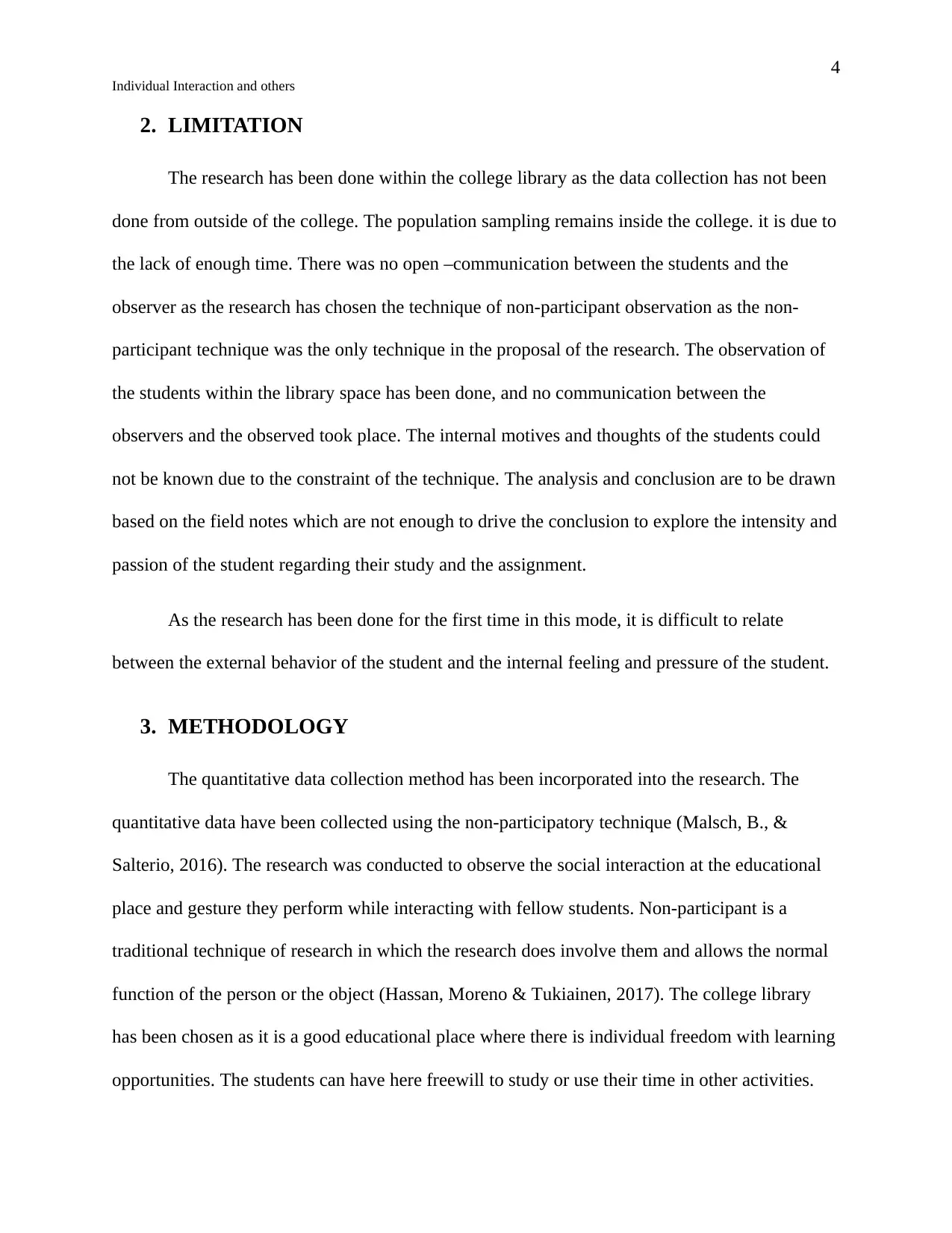
4
Individual Interaction and others
2. LIMITATION
The research has been done within the college library as the data collection has not been
done from outside of the college. The population sampling remains inside the college. it is due to
the lack of enough time. There was no open –communication between the students and the
observer as the research has chosen the technique of non-participant observation as the non-
participant technique was the only technique in the proposal of the research. The observation of
the students within the library space has been done, and no communication between the
observers and the observed took place. The internal motives and thoughts of the students could
not be known due to the constraint of the technique. The analysis and conclusion are to be drawn
based on the field notes which are not enough to drive the conclusion to explore the intensity and
passion of the student regarding their study and the assignment.
As the research has been done for the first time in this mode, it is difficult to relate
between the external behavior of the student and the internal feeling and pressure of the student.
3. METHODOLOGY
The quantitative data collection method has been incorporated into the research. The
quantitative data have been collected using the non-participatory technique (Malsch, B., &
Salterio, 2016). The research was conducted to observe the social interaction at the educational
place and gesture they perform while interacting with fellow students. Non-participant is a
traditional technique of research in which the research does involve them and allows the normal
function of the person or the object (Hassan, Moreno & Tukiainen, 2017). The college library
has been chosen as it is a good educational place where there is individual freedom with learning
opportunities. The students can have here freewill to study or use their time in other activities.
Individual Interaction and others
2. LIMITATION
The research has been done within the college library as the data collection has not been
done from outside of the college. The population sampling remains inside the college. it is due to
the lack of enough time. There was no open –communication between the students and the
observer as the research has chosen the technique of non-participant observation as the non-
participant technique was the only technique in the proposal of the research. The observation of
the students within the library space has been done, and no communication between the
observers and the observed took place. The internal motives and thoughts of the students could
not be known due to the constraint of the technique. The analysis and conclusion are to be drawn
based on the field notes which are not enough to drive the conclusion to explore the intensity and
passion of the student regarding their study and the assignment.
As the research has been done for the first time in this mode, it is difficult to relate
between the external behavior of the student and the internal feeling and pressure of the student.
3. METHODOLOGY
The quantitative data collection method has been incorporated into the research. The
quantitative data have been collected using the non-participatory technique (Malsch, B., &
Salterio, 2016). The research was conducted to observe the social interaction at the educational
place and gesture they perform while interacting with fellow students. Non-participant is a
traditional technique of research in which the research does involve them and allows the normal
function of the person or the object (Hassan, Moreno & Tukiainen, 2017). The college library
has been chosen as it is a good educational place where there is individual freedom with learning
opportunities. The students can have here freewill to study or use their time in other activities.
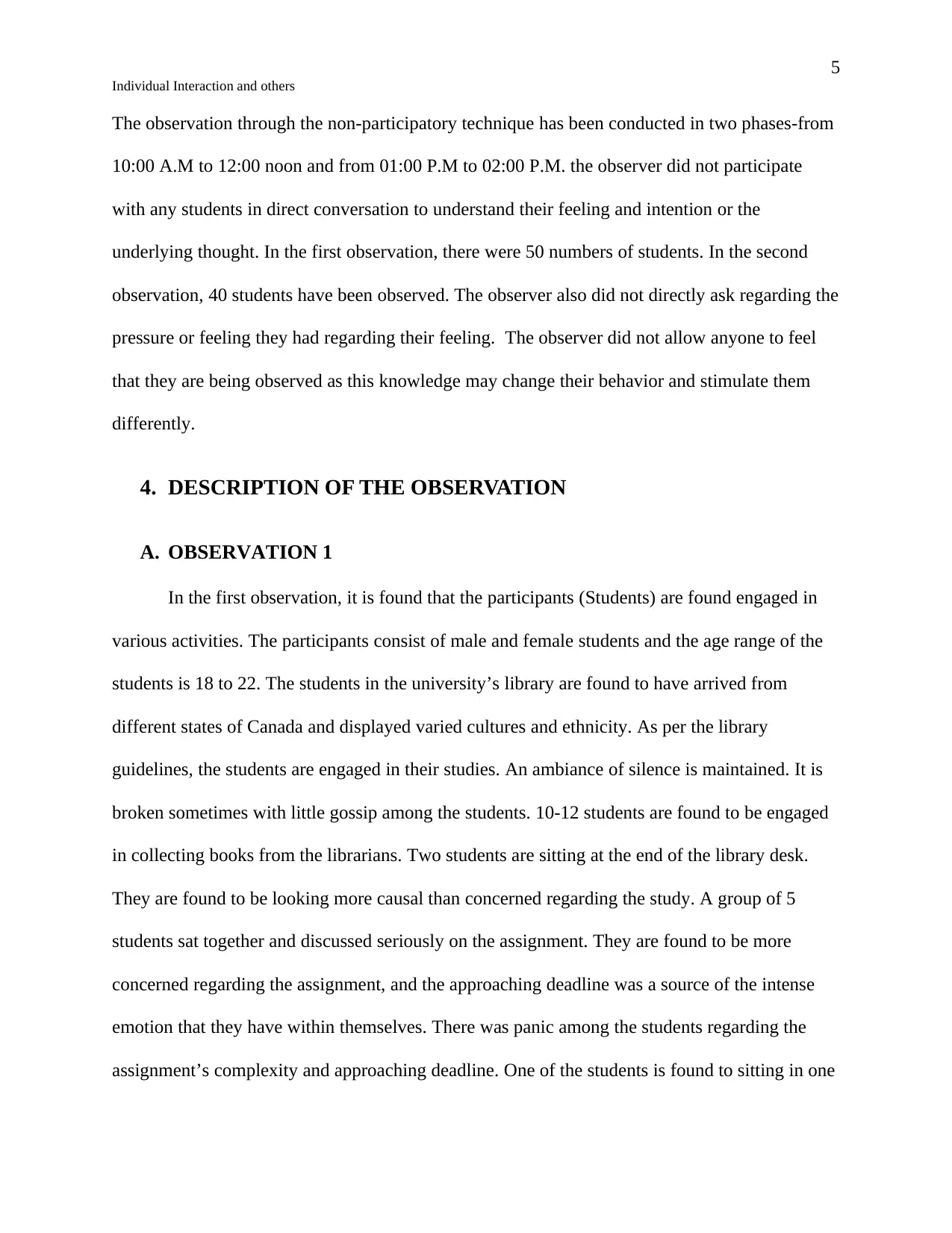
5
Individual Interaction and others
The observation through the non-participatory technique has been conducted in two phases-from
10:00 A.M to 12:00 noon and from 01:00 P.M to 02:00 P.M. the observer did not participate
with any students in direct conversation to understand their feeling and intention or the
underlying thought. In the first observation, there were 50 numbers of students. In the second
observation, 40 students have been observed. The observer also did not directly ask regarding the
pressure or feeling they had regarding their feeling. The observer did not allow anyone to feel
that they are being observed as this knowledge may change their behavior and stimulate them
differently.
4. DESCRIPTION OF THE OBSERVATION
A. OBSERVATION 1
In the first observation, it is found that the participants (Students) are found engaged in
various activities. The participants consist of male and female students and the age range of the
students is 18 to 22. The students in the university’s library are found to have arrived from
different states of Canada and displayed varied cultures and ethnicity. As per the library
guidelines, the students are engaged in their studies. An ambiance of silence is maintained. It is
broken sometimes with little gossip among the students. 10-12 students are found to be engaged
in collecting books from the librarians. Two students are sitting at the end of the library desk.
They are found to be looking more causal than concerned regarding the study. A group of 5
students sat together and discussed seriously on the assignment. They are found to be more
concerned regarding the assignment, and the approaching deadline was a source of the intense
emotion that they have within themselves. There was panic among the students regarding the
assignment’s complexity and approaching deadline. One of the students is found to sitting in one
Individual Interaction and others
The observation through the non-participatory technique has been conducted in two phases-from
10:00 A.M to 12:00 noon and from 01:00 P.M to 02:00 P.M. the observer did not participate
with any students in direct conversation to understand their feeling and intention or the
underlying thought. In the first observation, there were 50 numbers of students. In the second
observation, 40 students have been observed. The observer also did not directly ask regarding the
pressure or feeling they had regarding their feeling. The observer did not allow anyone to feel
that they are being observed as this knowledge may change their behavior and stimulate them
differently.
4. DESCRIPTION OF THE OBSERVATION
A. OBSERVATION 1
In the first observation, it is found that the participants (Students) are found engaged in
various activities. The participants consist of male and female students and the age range of the
students is 18 to 22. The students in the university’s library are found to have arrived from
different states of Canada and displayed varied cultures and ethnicity. As per the library
guidelines, the students are engaged in their studies. An ambiance of silence is maintained. It is
broken sometimes with little gossip among the students. 10-12 students are found to be engaged
in collecting books from the librarians. Two students are sitting at the end of the library desk.
They are found to be looking more causal than concerned regarding the study. A group of 5
students sat together and discussed seriously on the assignment. They are found to be more
concerned regarding the assignment, and the approaching deadline was a source of the intense
emotion that they have within themselves. There was panic among the students regarding the
assignment’s complexity and approaching deadline. One of the students is found to sitting in one
⊘ This is a preview!⊘
Do you want full access?
Subscribe today to unlock all pages.

Trusted by 1+ million students worldwide
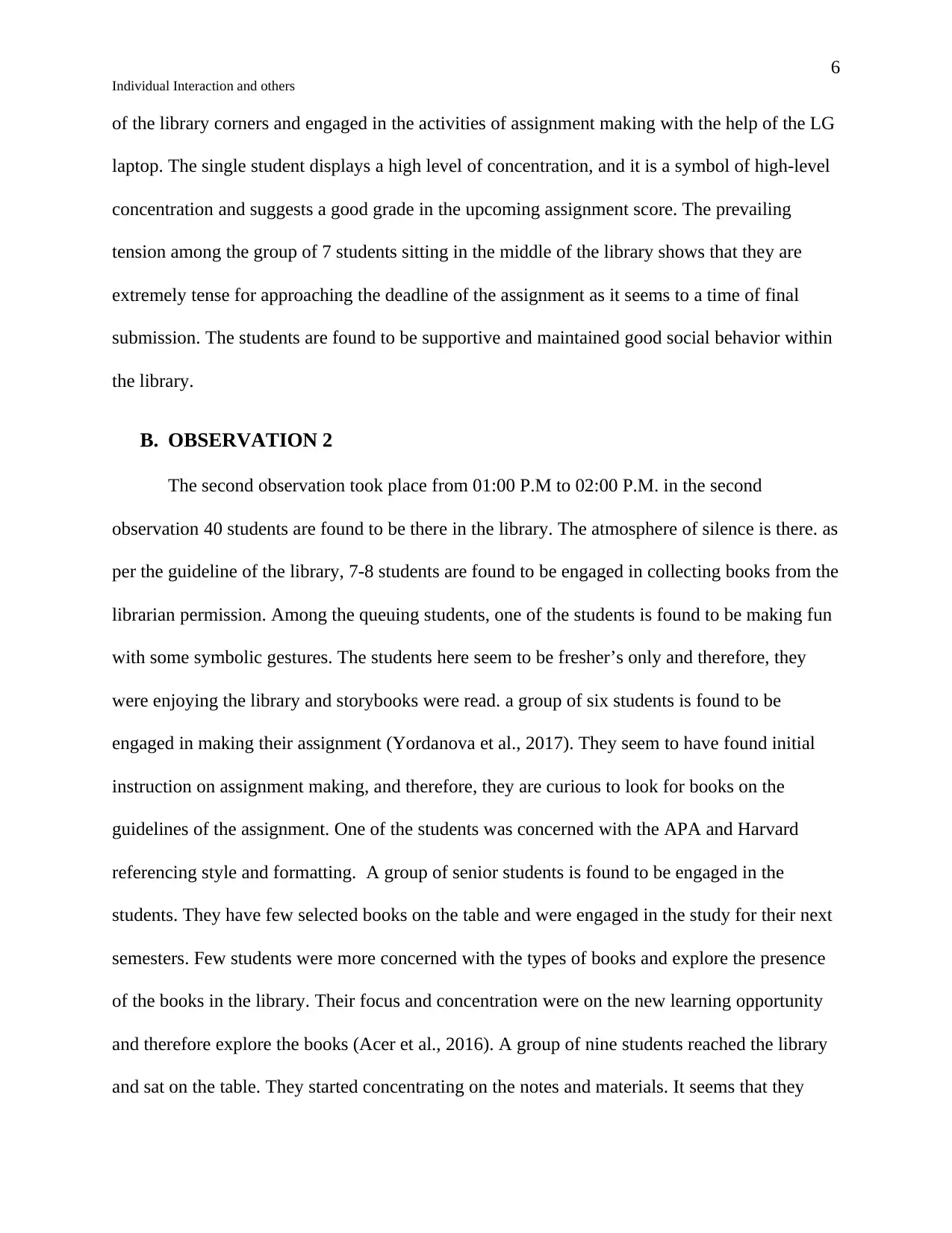
6
Individual Interaction and others
of the library corners and engaged in the activities of assignment making with the help of the LG
laptop. The single student displays a high level of concentration, and it is a symbol of high-level
concentration and suggests a good grade in the upcoming assignment score. The prevailing
tension among the group of 7 students sitting in the middle of the library shows that they are
extremely tense for approaching the deadline of the assignment as it seems to a time of final
submission. The students are found to be supportive and maintained good social behavior within
the library.
B. OBSERVATION 2
The second observation took place from 01:00 P.M to 02:00 P.M. in the second
observation 40 students are found to be there in the library. The atmosphere of silence is there. as
per the guideline of the library, 7-8 students are found to be engaged in collecting books from the
librarian permission. Among the queuing students, one of the students is found to be making fun
with some symbolic gestures. The students here seem to be fresher’s only and therefore, they
were enjoying the library and storybooks were read. a group of six students is found to be
engaged in making their assignment (Yordanova et al., 2017). They seem to have found initial
instruction on assignment making, and therefore, they are curious to look for books on the
guidelines of the assignment. One of the students was concerned with the APA and Harvard
referencing style and formatting. A group of senior students is found to be engaged in the
students. They have few selected books on the table and were engaged in the study for their next
semesters. Few students were more concerned with the types of books and explore the presence
of the books in the library. Their focus and concentration were on the new learning opportunity
and therefore explore the books (Acer et al., 2016). A group of nine students reached the library
and sat on the table. They started concentrating on the notes and materials. It seems that they
Individual Interaction and others
of the library corners and engaged in the activities of assignment making with the help of the LG
laptop. The single student displays a high level of concentration, and it is a symbol of high-level
concentration and suggests a good grade in the upcoming assignment score. The prevailing
tension among the group of 7 students sitting in the middle of the library shows that they are
extremely tense for approaching the deadline of the assignment as it seems to a time of final
submission. The students are found to be supportive and maintained good social behavior within
the library.
B. OBSERVATION 2
The second observation took place from 01:00 P.M to 02:00 P.M. in the second
observation 40 students are found to be there in the library. The atmosphere of silence is there. as
per the guideline of the library, 7-8 students are found to be engaged in collecting books from the
librarian permission. Among the queuing students, one of the students is found to be making fun
with some symbolic gestures. The students here seem to be fresher’s only and therefore, they
were enjoying the library and storybooks were read. a group of six students is found to be
engaged in making their assignment (Yordanova et al., 2017). They seem to have found initial
instruction on assignment making, and therefore, they are curious to look for books on the
guidelines of the assignment. One of the students was concerned with the APA and Harvard
referencing style and formatting. A group of senior students is found to be engaged in the
students. They have few selected books on the table and were engaged in the study for their next
semesters. Few students were more concerned with the types of books and explore the presence
of the books in the library. Their focus and concentration were on the new learning opportunity
and therefore explore the books (Acer et al., 2016). A group of nine students reached the library
and sat on the table. They started concentrating on the notes and materials. It seems that they
Paraphrase This Document
Need a fresh take? Get an instant paraphrase of this document with our AI Paraphraser

7
Individual Interaction and others
have found these notes from their professors after the class lecture. The students are found
leaving after collecting the book, and at 2:00 P.M, it was announced that the library is to be
closed after 3:00 P.M. the silence of the library is broken by the sound of the arriving the new
students and leaving few students. The arrival and departure cause distraction among the students
who are concerned with their study.
5. ANALYSIS OF RESULT
At the initial observation, the seriousness of the students has been revealed. The students
are engaged in the assignment activities, and the intensity of their engagement is evident with
their tense face and high level of concentration (Athanases & Heath,1995). The lonely student
working on the laptop shows his deeper engagement and sincerity to deliver the assignment on
time. He seems to have accomplished most of the part of the assignment and is, therefore, feeling
happy with the work as he seems to be at the end of the assignment (Xu, Sun & Hu, 2018). The
group interaction depicts the student's group activities help them to learn from their mistakes,
and flaws and shortcomings are removed with the discussion on the selected topic of the study.
The intense emotion displayed by the student due to the approaching deadline shows their
consciousness regarding the work assigned. This sincere and responsive behavior will be helpful
while dealing with the other problem of their life (Carnawi, Sudarmin & Wijayati, 2017). The
group interaction helps them to cope with the stress and learn the good manner and respect the
guidelines of the place. The students are more focused on maintaining silence as it may cause
disturbance to others within the library. The students standing in a raw indicates that they are
conforming to the guidelines framed by the university to avoid chaos within the library (James et
al., 2019). Conforming to the guidelines and social discipline is the basic characteristics of the
Individual Interaction and others
have found these notes from their professors after the class lecture. The students are found
leaving after collecting the book, and at 2:00 P.M, it was announced that the library is to be
closed after 3:00 P.M. the silence of the library is broken by the sound of the arriving the new
students and leaving few students. The arrival and departure cause distraction among the students
who are concerned with their study.
5. ANALYSIS OF RESULT
At the initial observation, the seriousness of the students has been revealed. The students
are engaged in the assignment activities, and the intensity of their engagement is evident with
their tense face and high level of concentration (Athanases & Heath,1995). The lonely student
working on the laptop shows his deeper engagement and sincerity to deliver the assignment on
time. He seems to have accomplished most of the part of the assignment and is, therefore, feeling
happy with the work as he seems to be at the end of the assignment (Xu, Sun & Hu, 2018). The
group interaction depicts the student's group activities help them to learn from their mistakes,
and flaws and shortcomings are removed with the discussion on the selected topic of the study.
The intense emotion displayed by the student due to the approaching deadline shows their
consciousness regarding the work assigned. This sincere and responsive behavior will be helpful
while dealing with the other problem of their life (Carnawi, Sudarmin & Wijayati, 2017). The
group interaction helps them to cope with the stress and learn the good manner and respect the
guidelines of the place. The students are more focused on maintaining silence as it may cause
disturbance to others within the library. The students standing in a raw indicates that they are
conforming to the guidelines framed by the university to avoid chaos within the library (James et
al., 2019). Conforming to the guidelines and social discipline is the basic characteristics of the
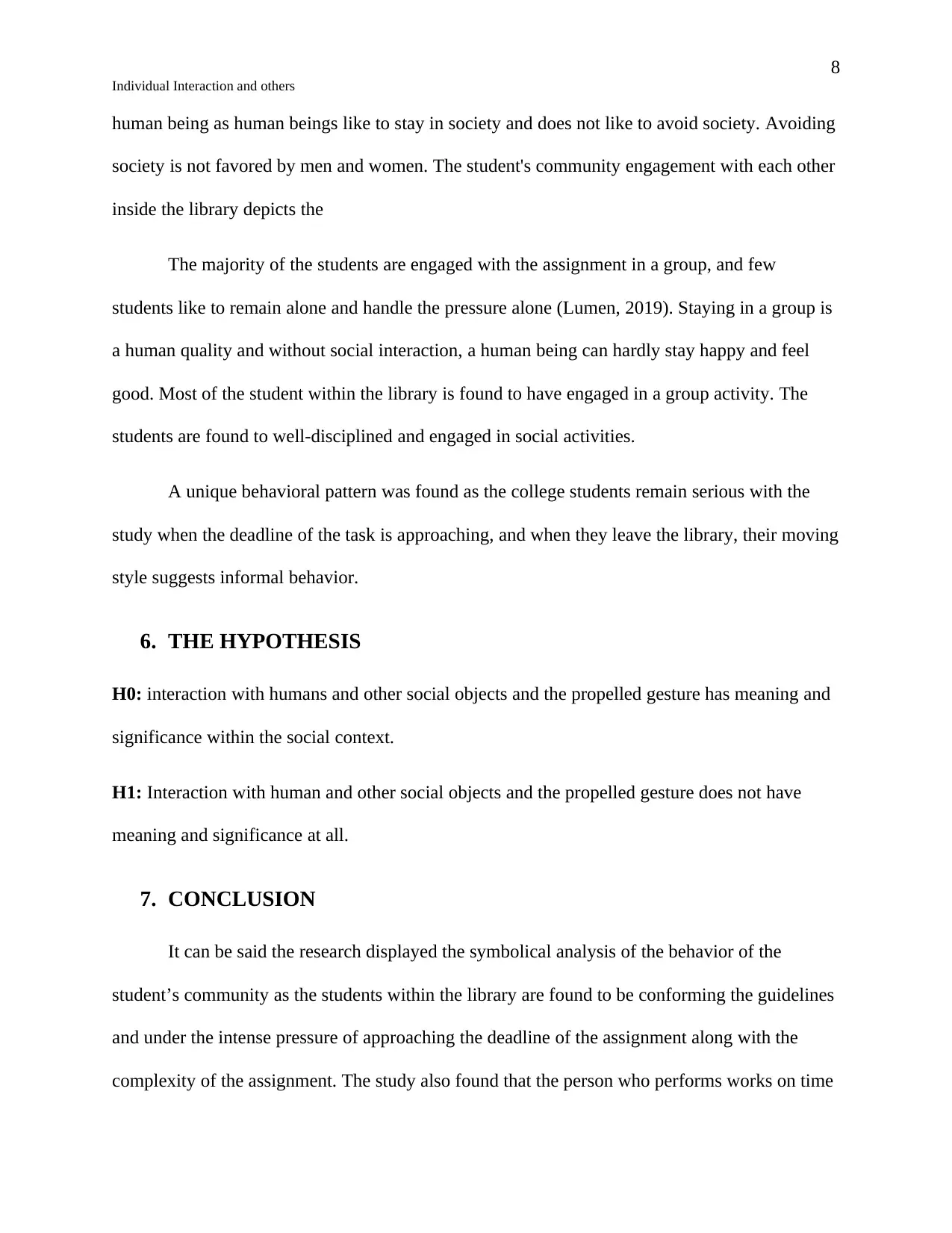
8
Individual Interaction and others
human being as human beings like to stay in society and does not like to avoid society. Avoiding
society is not favored by men and women. The student's community engagement with each other
inside the library depicts the
The majority of the students are engaged with the assignment in a group, and few
students like to remain alone and handle the pressure alone (Lumen, 2019). Staying in a group is
a human quality and without social interaction, a human being can hardly stay happy and feel
good. Most of the student within the library is found to have engaged in a group activity. The
students are found to well-disciplined and engaged in social activities.
A unique behavioral pattern was found as the college students remain serious with the
study when the deadline of the task is approaching, and when they leave the library, their moving
style suggests informal behavior.
6. THE HYPOTHESIS
H0: interaction with humans and other social objects and the propelled gesture has meaning and
significance within the social context.
H1: Interaction with human and other social objects and the propelled gesture does not have
meaning and significance at all.
7. CONCLUSION
It can be said the research displayed the symbolical analysis of the behavior of the
student’s community as the students within the library are found to be conforming the guidelines
and under the intense pressure of approaching the deadline of the assignment along with the
complexity of the assignment. The study also found that the person who performs works on time
Individual Interaction and others
human being as human beings like to stay in society and does not like to avoid society. Avoiding
society is not favored by men and women. The student's community engagement with each other
inside the library depicts the
The majority of the students are engaged with the assignment in a group, and few
students like to remain alone and handle the pressure alone (Lumen, 2019). Staying in a group is
a human quality and without social interaction, a human being can hardly stay happy and feel
good. Most of the student within the library is found to have engaged in a group activity. The
students are found to well-disciplined and engaged in social activities.
A unique behavioral pattern was found as the college students remain serious with the
study when the deadline of the task is approaching, and when they leave the library, their moving
style suggests informal behavior.
6. THE HYPOTHESIS
H0: interaction with humans and other social objects and the propelled gesture has meaning and
significance within the social context.
H1: Interaction with human and other social objects and the propelled gesture does not have
meaning and significance at all.
7. CONCLUSION
It can be said the research displayed the symbolical analysis of the behavior of the
student’s community as the students within the library are found to be conforming the guidelines
and under the intense pressure of approaching the deadline of the assignment along with the
complexity of the assignment. The study also found that the person who performs works on time
⊘ This is a preview!⊘
Do you want full access?
Subscribe today to unlock all pages.

Trusted by 1+ million students worldwide
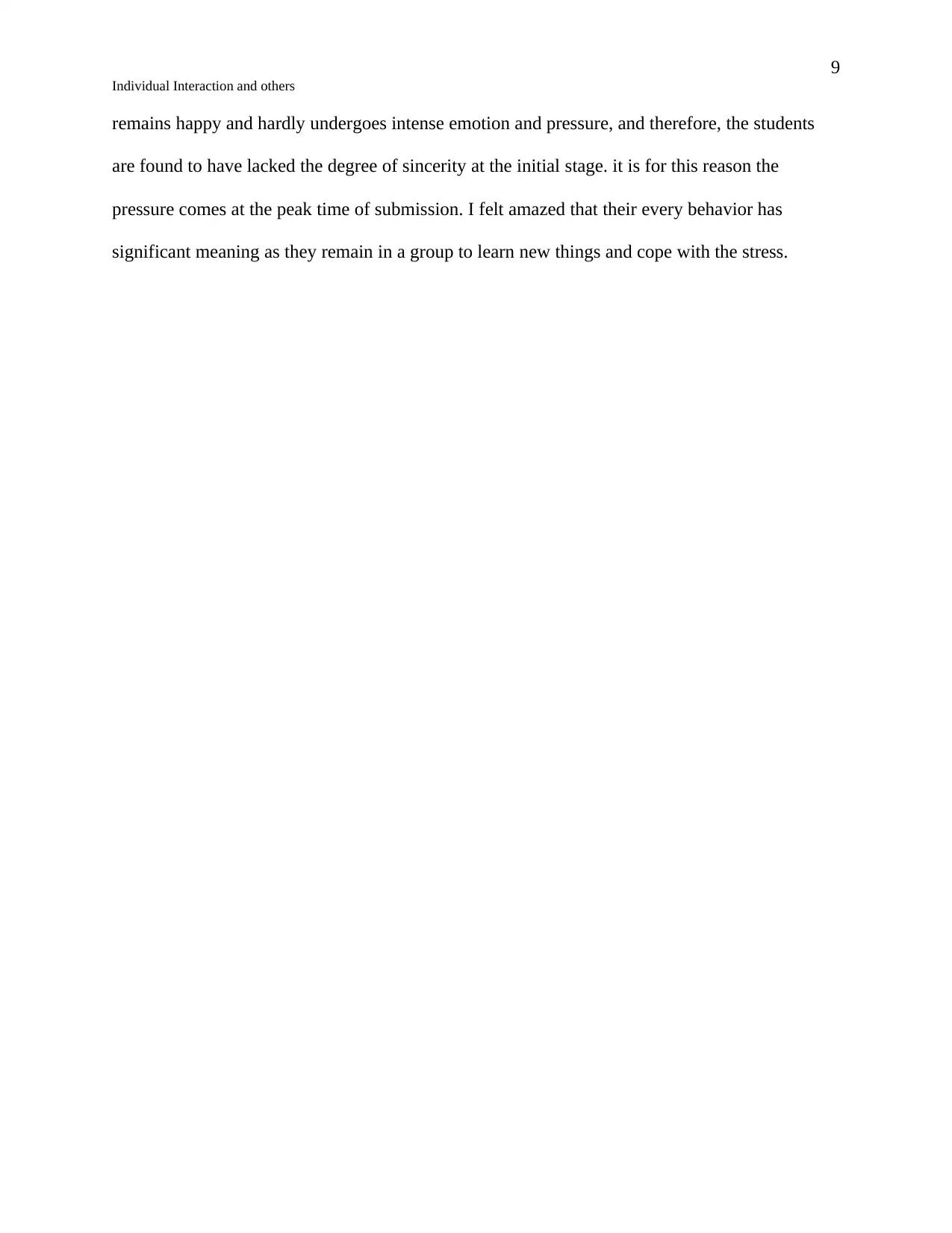
9
Individual Interaction and others
remains happy and hardly undergoes intense emotion and pressure, and therefore, the students
are found to have lacked the degree of sincerity at the initial stage. it is for this reason the
pressure comes at the peak time of submission. I felt amazed that their every behavior has
significant meaning as they remain in a group to learn new things and cope with the stress.
Individual Interaction and others
remains happy and hardly undergoes intense emotion and pressure, and therefore, the students
are found to have lacked the degree of sincerity at the initial stage. it is for this reason the
pressure comes at the peak time of submission. I felt amazed that their every behavior has
significant meaning as they remain in a group to learn new things and cope with the stress.
Paraphrase This Document
Need a fresh take? Get an instant paraphrase of this document with our AI Paraphraser
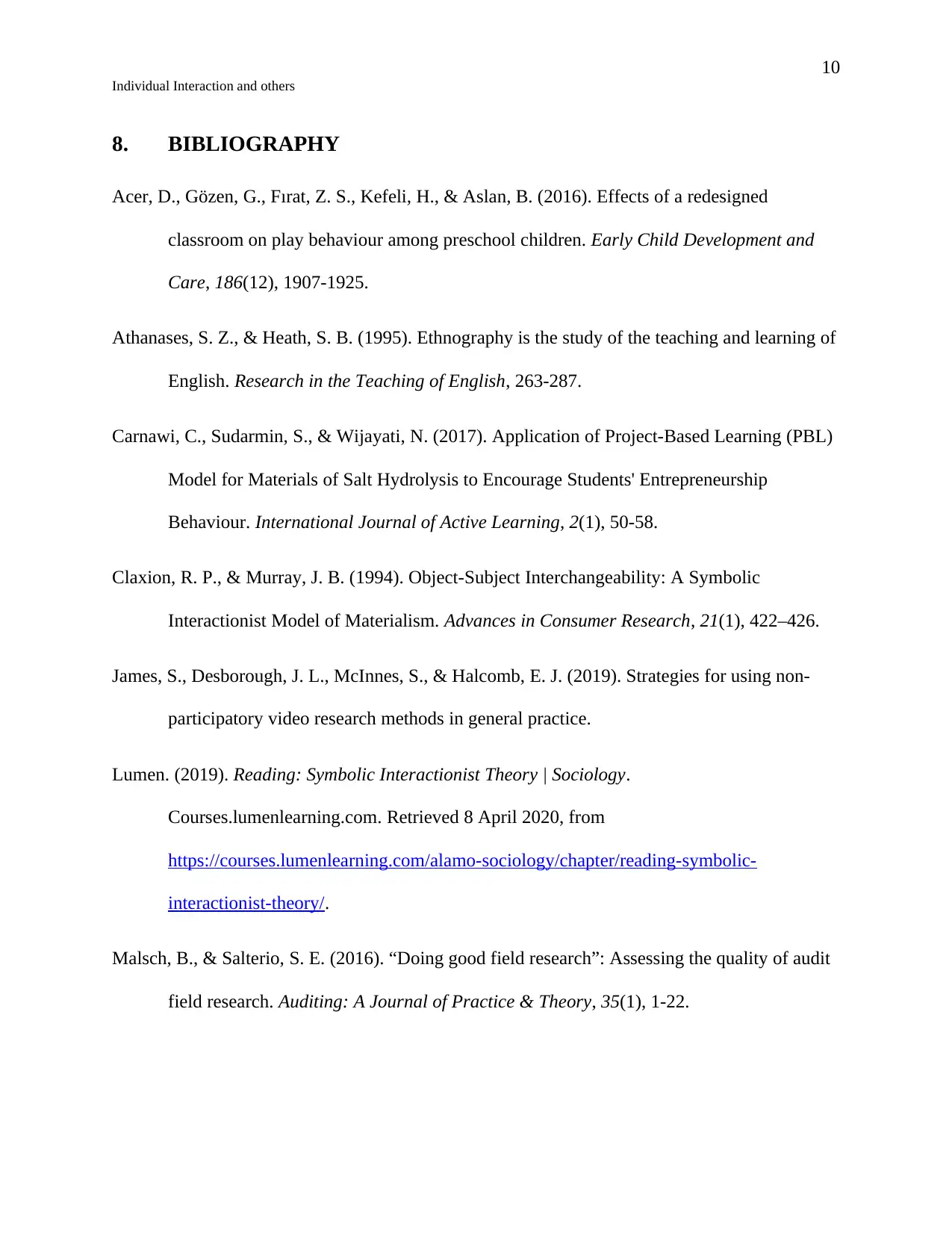
10
Individual Interaction and others
8. BIBLIOGRAPHY
Acer, D., Gözen, G., Fırat, Z. S., Kefeli, H., & Aslan, B. (2016). Effects of a redesigned
classroom on play behaviour among preschool children. Early Child Development and
Care, 186(12), 1907-1925.
Athanases, S. Z., & Heath, S. B. (1995). Ethnography is the study of the teaching and learning of
English. Research in the Teaching of English, 263-287.
Carnawi, C., Sudarmin, S., & Wijayati, N. (2017). Application of Project-Based Learning (PBL)
Model for Materials of Salt Hydrolysis to Encourage Students' Entrepreneurship
Behaviour. International Journal of Active Learning, 2(1), 50-58.
Claxion, R. P., & Murray, J. B. (1994). Object-Subject Interchangeability: A Symbolic
Interactionist Model of Materialism. Advances in Consumer Research, 21(1), 422–426.
James, S., Desborough, J. L., McInnes, S., & Halcomb, E. J. (2019). Strategies for using non-
participatory video research methods in general practice.
Lumen. (2019). Reading: Symbolic Interactionist Theory | Sociology.
Courses.lumenlearning.com. Retrieved 8 April 2020, from
https://courses.lumenlearning.com/alamo-sociology/chapter/reading-symbolic-
interactionist-theory/.
Malsch, B., & Salterio, S. E. (2016). “Doing good field research”: Assessing the quality of audit
field research. Auditing: A Journal of Practice & Theory, 35(1), 1-22.
Individual Interaction and others
8. BIBLIOGRAPHY
Acer, D., Gözen, G., Fırat, Z. S., Kefeli, H., & Aslan, B. (2016). Effects of a redesigned
classroom on play behaviour among preschool children. Early Child Development and
Care, 186(12), 1907-1925.
Athanases, S. Z., & Heath, S. B. (1995). Ethnography is the study of the teaching and learning of
English. Research in the Teaching of English, 263-287.
Carnawi, C., Sudarmin, S., & Wijayati, N. (2017). Application of Project-Based Learning (PBL)
Model for Materials of Salt Hydrolysis to Encourage Students' Entrepreneurship
Behaviour. International Journal of Active Learning, 2(1), 50-58.
Claxion, R. P., & Murray, J. B. (1994). Object-Subject Interchangeability: A Symbolic
Interactionist Model of Materialism. Advances in Consumer Research, 21(1), 422–426.
James, S., Desborough, J. L., McInnes, S., & Halcomb, E. J. (2019). Strategies for using non-
participatory video research methods in general practice.
Lumen. (2019). Reading: Symbolic Interactionist Theory | Sociology.
Courses.lumenlearning.com. Retrieved 8 April 2020, from
https://courses.lumenlearning.com/alamo-sociology/chapter/reading-symbolic-
interactionist-theory/.
Malsch, B., & Salterio, S. E. (2016). “Doing good field research”: Assessing the quality of audit
field research. Auditing: A Journal of Practice & Theory, 35(1), 1-22.
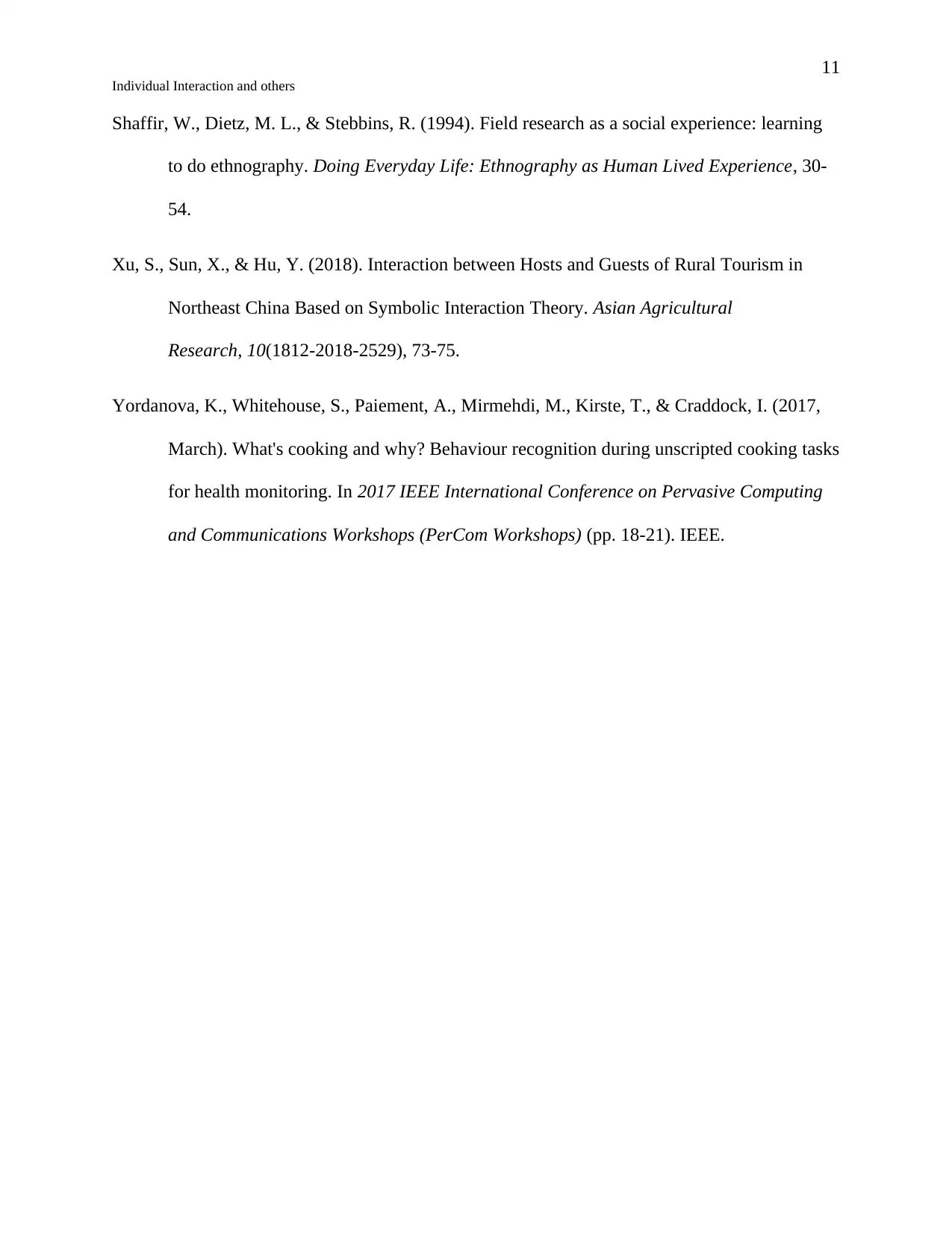
11
Individual Interaction and others
Shaffir, W., Dietz, M. L., & Stebbins, R. (1994). Field research as a social experience: learning
to do ethnography. Doing Everyday Life: Ethnography as Human Lived Experience, 30-
54.
Xu, S., Sun, X., & Hu, Y. (2018). Interaction between Hosts and Guests of Rural Tourism in
Northeast China Based on Symbolic Interaction Theory. Asian Agricultural
Research, 10(1812-2018-2529), 73-75.
Yordanova, K., Whitehouse, S., Paiement, A., Mirmehdi, M., Kirste, T., & Craddock, I. (2017,
March). What's cooking and why? Behaviour recognition during unscripted cooking tasks
for health monitoring. In 2017 IEEE International Conference on Pervasive Computing
and Communications Workshops (PerCom Workshops) (pp. 18-21). IEEE.
Individual Interaction and others
Shaffir, W., Dietz, M. L., & Stebbins, R. (1994). Field research as a social experience: learning
to do ethnography. Doing Everyday Life: Ethnography as Human Lived Experience, 30-
54.
Xu, S., Sun, X., & Hu, Y. (2018). Interaction between Hosts and Guests of Rural Tourism in
Northeast China Based on Symbolic Interaction Theory. Asian Agricultural
Research, 10(1812-2018-2529), 73-75.
Yordanova, K., Whitehouse, S., Paiement, A., Mirmehdi, M., Kirste, T., & Craddock, I. (2017,
March). What's cooking and why? Behaviour recognition during unscripted cooking tasks
for health monitoring. In 2017 IEEE International Conference on Pervasive Computing
and Communications Workshops (PerCom Workshops) (pp. 18-21). IEEE.
⊘ This is a preview!⊘
Do you want full access?
Subscribe today to unlock all pages.

Trusted by 1+ million students worldwide
1 out of 15
Related Documents
Your All-in-One AI-Powered Toolkit for Academic Success.
+13062052269
info@desklib.com
Available 24*7 on WhatsApp / Email
![[object Object]](/_next/static/media/star-bottom.7253800d.svg)
Unlock your academic potential
Copyright © 2020–2025 A2Z Services. All Rights Reserved. Developed and managed by ZUCOL.





